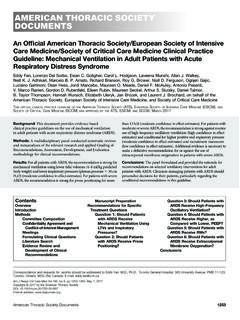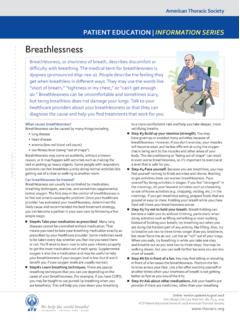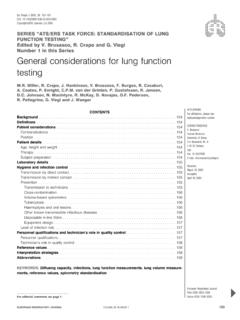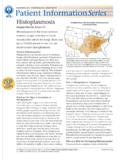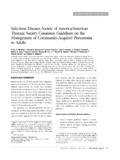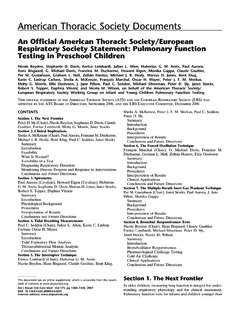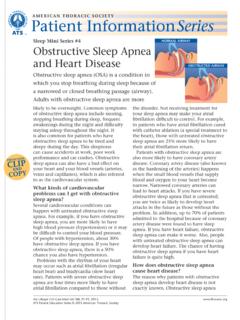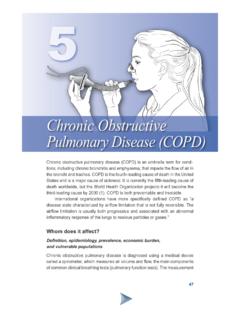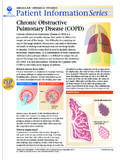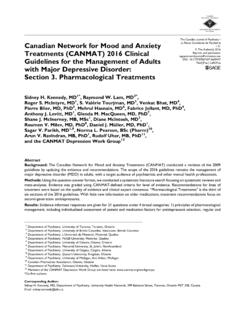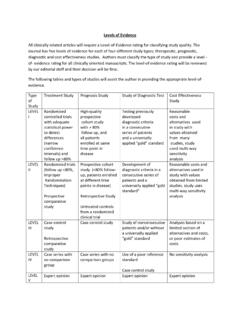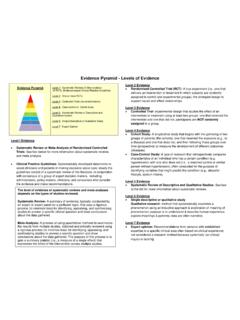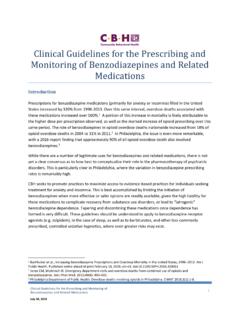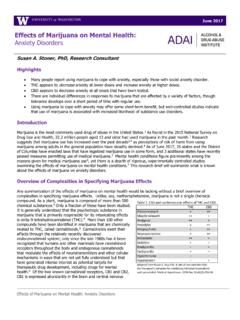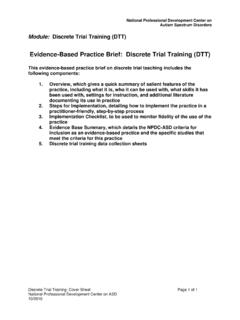Transcription of American Thoracic Society Documents
1 American Thoracic Society DocumentsAn Official ATS clinical Practice Guideline:Interpretation of Exhaled Nitric Oxide Levels (FENO)for clinical ApplicationsRaed A. Dweik, Peter B. Boggs, Serpil C. Erzurum, Charles G. Irvin, Margaret W. Leigh, Jon O. Lundberg,Anna-Carin Olin, Alan L. Plummer, D. Robin Taylor, on behalf of the American Thoracic Society Committeeon Interpretation of Exhaled Nitric Oxide Levels (FENO) for clinical ApplicationsTHISOFFICIALCLINICALPRACTICE GUIDELINE OF THEAMERICANTHORACICSOCIETY(ATS)WAS APPROVED BY THEATS BOARDOFDIRECTORS,MAY2011 CONTENTSE xecutive SummaryIntroductionMethodsCommittee Composition, Meetings, and Document PreparationDocument StructureQuality of evidence and Strength of RecommendationsWhy Should a FENOTest be Obtained?Can FENOBe Used to Diagnose Asthma?FENOIs Associated with Eosinophilic Airway InflammationFENOP redicts Likelihood of Corticosteroid ResponsivenessFENOCan Support a Diagnosis of AsthmaFENOMay Predict AHRIs There a Normal FENOV alue?
2 Normal Values versus Relevant Cut Points for FENOC onfounding Factors that May Affect FENOWhat Are the Clinically Significant Cut Points for FENO?Low FENO(,25 ppb in Adults; 20 ppb in Children)High FENO(.50 ppb in Adults, 35 ppb in Children)Intermediate FENO(between 25 ppb and 50 ppb in Adults;20 35 ppb in Children)Persistently High FENO(.50 ppb in adults, 35 ppb in Children)Can FENOBe Used to Monitor Airway Inflammation?Monitoring Airway Inflammation in AsthmaMinimally Important Differences, and Prognostic Significanceof FENOHow Should a FENOM easurement Be Interpreted and Reported?Other Situations in which FENOMay Be UsefulCOPDP ulmonary HypertensionCystic Fibrosis and Nasal NO MeasurementsConclusions and Future DirectionsOnline SupplementAppendix E1: Methods ChecklistAppendix E2: Technical Considerations and Sources of Variationin FENOA ppendix E3: Causes of High and Low FENOL evelsAppendix E4: Case StudiesBackground: Measurement of fractional nitric oxide (NO) concentra-tion in exhaled breath (FENO) is a quantitative, noninvasive, simple,and safe method of measuring airway inflammation that providesa complementary tool to other ways of assessing airways disease,including asthma.
3 While FENO measurement has been standardized,there is currently no reference guideline for practicing health careproviders to guide themin the appropriate useand interpretation ofFENOin clinical : To develop evidence -based guidelines for the interpreta-tion of FENO measurements that incorporate evidence that has accu-mulated over the past : We createda multidisciplinary committee with expertiseinthe clinical care, clinical science, or basic science of airway diseaseand/or NO. The committee identified important clinical questions,synthesized the evidence , and formulated recommendations. Rec-ommendations were developed using pragmatic systematic reviewsof the literature and the GRADE : The evidence related to the use of FENO measurements isreviewed and clinical practice recommendations are : In the setting of chronic inflammatory airway diseaseincluding asthma, conventional tests such as FEV1reversibility orprovocation tests are only indirectly associated with airway ,butnot limited to (1) detecting of eosinophilic airway inflammation, (2)determining the likelihood of corticosteroid responsiveness, (3)monitoring of airway inflammation to determine the potential needforcorticosteroid,and(4)unmaskingofo therwiseunsuspectednon-adherence to corticosteroid :nitric oxide; asthma; inflammation; airway disease; exhaledbreath; clinical applicationEXECUTIVE SUMMARYN itric oxide (NO) is now recognized as a biological mediator inanimals and humans.
4 NO is produced by the human lung and ispresent in the exhaled breath. It has been implicated in the path-ophysiology of lung diseases, including asthma. The measure-ment of exhaled NO has been standardized for clinical studies have provided evidence regarding the appli-cations of NO measurements in clinical practice, together withthe performance characteristics and the strengths and the weak-nesses of the test. Based on this evidence , this clinical PracticeGuideline is designed to guide clinicians as to how exhaled NOmeasurements should be used and QUALITY AND RECOMMENDATIONST hese recommendations may vary with respect to the particulartarget population. Where this is the case, this has been includedThis article has an online supplement, which is available from this issue s table ofcontents at J Respir Crit Care Med Vol 184. pp 602 615, 2011 DOI: address: the recommendation. If not stated, then the recommendationapplies to patients with recommend the use of FENOin the diagnosis of eosin-ophilic airway inflammation (strong recommendation,moderate quality of evidence ).
5 DWe recommend the use of FENOin determining the likeli-hood of steroid responsiveness in individuals with chronicrespiratory symptoms possibly due to airway inflammation(strong recommendation, low quality of evidence ).dWe suggest that FENOmay be used to support the diagnosisof asthma in situations in which objective evidence is needed(weak recommendation, moderate quality of evidence ).dWe suggest the use of cut points rather than referencevalues when interpreting FENO levels (weak recommenda-tion, low quality of evidence ).dWe recommend accounting for age as a factor affectingFENOin children younger than 12 years of age (strongrecommendation, high quality of evidence ).dWe recommend that low FENO less than 25 ppb (,20 ppbin children) be used to indicate that eosinophilic inflam-mation and responsiveness to corticosteroids are less likely(strong recommendation, moderate quality of evidence ).dWe recommend that FENO greater than 50 ppb (.35 ppbin children) be used to indicate that eosinophilic inflam-mation and, in symptomatic patients, responsiveness tocorticosteroids are likely (strong recommendation, moder-ate quality of evidence ).
6 DWe recommend that FENO values between 25 ppb and50 ppb (20 35 ppb in children) should be interpreted cau-tiously and with reference to the clinical context. (strongrecommendation, low quality of evidence ).dWe recommend accounting for persistent and/or high aller-gen exposure as a factor associated with higher levels of FENO(strong recommendation, moderate quality of evidence ).dWe recommend the use of FENOin monitoring airway in-flammation in patients with asthma (strong recommenda-tion, low quality of evidence ).dWe suggest using the following values to determine a sig-nificant increase in FENO: greater than 20% for values over50 ppb or more than 10 ppb for values lower than 50 ppbfrom one visit to the next (weak recommendation, lowquality of evidence ).dWe suggest using a reduction of at least 20% in FENO forvalues over 50 ppb or more than 10 ppb for values lowerthan 50 ppb as the cut point to indicate a significant re-sponse to antiinflammatory therapy (weak recommenda-tion, low quality of evidence ).
7 Conclusion: Advances in technology and standardizationhave made FENO measurement simple, permitting its use as abiomarker that adds a new dimension to the traditional clinicaltools in the assessment and management of airways guidelines for interpretation of FENO measurements aremeant to enhance their clinical utility, but more work is still neededto better define the use of FENOin different clinical has long been known as an atmospheric pollutant present invehicle exhaust emissions and cigarette smoke, and more re-cently its clinical importance as a biological mediator in animalsand humans has been recognized (1, 2). NO is present in virtu-ally all mammalian organ systems and is produced by the hu-man lung. It is present in the exhaled breath of all humans (3).NO is recognized to play key roles in virtually all aspects of lungbiology and has been implicated in the pathophysiology of lungdiseases, including asthma (4). The functions and effects of NOin the lung/airways reflect its key roles as a vasodilator, bron-chodilator, neurotransmitter, and inflammatory mediator (3).
8 Patients with asthma have high levels of NO in their exhaledbreath and high levels of inducible nitric oxide synthase (NOS2)enzyme expression in the epithelial cells of their airways, sug-gesting a role for NO in asthma pathogenesis (5). NO is a highlyreactive molecule/free radical and may have oxidant propertiesdirectly or in the form of the more noxious peroxynitrite. Theseproperties give NO its bactericidal and cytotoxic effects andmay participate in host defense by mediating antimicrobial ac-tivity and cytotoxicity for tumor cells (4). The exact pathophys-iological role of NO in the airways and lungs is complex (4, 6 8).On the one hand, it may act as a proinflammatory mediatorpredisposing to the development of airway hyperresponsiveness(AHR) (4, 9). On the other, under physiological conditions NOacts as a weak mediator of smooth muscle relaxation, and pro-tects against AHR (4, 10). In exhaled air, NO appears to orig-inate in the airway epithelium (5, 11 15), as a result of NOS2up-regulation which occurs with inflammation (5, 12, 13, 16).
9 Thus, exhaled NO may be regarded as an indirect marker forup-regulation of airway field of exhaled NO measurement has developed remark-ably over the last 15 years. The use of chemiluminescence analyzersallowed for the detection of NO in exhaled breath in the early1990s (17). Patients with asthma were found to have high FENOin their exhaled breath (18 20) that decreased in response totreatment with corticosteroids (21). This quickly prompted theevaluation of FENOas a potential noninvasive method to diagnoseasthma and monitor the response to antiinflammatory for FENO include the noninvasive nature of the test,ease of repeat measurements, and the relatively easy use in patientswith severe airflow obstruction where other techniques are difficultto perform (22). By providing information about airway inflamma-tion (23, 24), FENO adds a new dimension to the traditional clinicaltools (history, physical exam,andlungfunctiontests).Before FENO could become useful as a clinical tool, severalissues needed to be addressed (25).
10 In particular, the methodsand equipment for measuring FENO needed to be standardized(26, 27). Large population studies were needed to determineeffect of confounding factors and provide the normal range oruseful cutoff points of FENO levels (22, 25). Most of these issueshave either already been addressed or are currently under in-vestigation, allowing FENO measurement to make the transitionfrom research into the clinical arena. Last, but not least, inter-pretative strategies need to be devised and put in place for thedifferent potential uses and applications (28). The purpose ofthis document is to address this last possible, the recommendations are based on pub-lished material, including abstracts, as referenced, but they aresupplemented by nonsystematic observations of experts in thefield. The guidelines are provided with the clear understandingthat this will be a rapidly evolving area and that periodic updat-ing will be Composition, Meetings, andDocument PreparationThe project Chair ( ) assembled a group of internationalexperts in exhaled nitric oxide.
